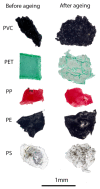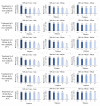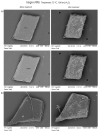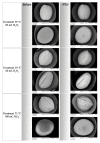Effects and Impacts of Different Oxidative Digestion Treatments on Virgin and Aged Microplastic Particles
- PMID: 35631840
- PMCID: PMC9146394
- DOI: 10.3390/polym14101958
Effects and Impacts of Different Oxidative Digestion Treatments on Virgin and Aged Microplastic Particles
Abstract
Although several sample preparation methods for analyzing microplastics (MPs) in environmental matrices have been implemented in recent years, important uncertainties and criticalities in the approaches adopted still persist. Preliminary purification of samples, based on oxidative digestion, is an important phase to isolate microplastics from the environmental matrix; it should guarantee both efficacy and minimal damage to the particles. In this context, our study aims to evaluate Fenton's reaction digestion pre-treatment used to isolate and extract microplastics from environmental matrices. We evaluated the particle recovery efficiency and the impact of the oxidation method on the integrity of the MPs subjected to digestion considering different particles' polymeric composition, size, and morphology. For this purpose, two laboratory experiments were set up: the first one to evaluate the efficacy of various digestion protocols in the MPs extraction from a complex matrix, and the second one to assess the possible harm of different treatments, differing in temperatures and volume reagents used, on virgin and aged MPs. Morphological, physicochemical, and dimensional changes were verified by Scanning Electron Microscope (SEM) and Fourier Transformed Infrared (FTIR) spectroscopy. The findings of the first experiment showed the greatest difference in recovery rates especially for polyvinyl chloride and polyethylene terephthalate particles, indicating the role of temperature and the kind of polymer as the major factors influencing MPs extraction. In the second experiment, the SEM analysis revealed morphological and particle size alterations of various entities, in particular for the particles treated at 75 °C and with major evident alterations of aged MPs to virgin ones. In conclusion, this study highlights how several factors, including temperature and polymer, influence the integrity of the particles altering the quality of the final data.
Keywords: FTIR; Fenton’s reagent; SEM; aged; microplastics; oxidative digestion; virgin; weathering.
Conflict of interest statement
The authors declare no conflict of interest.
Figures















References
-
- Gasperi J., Wright S.L., Dris R., Collard F., Mandin C., Guerrouache M., Langlois V., Kelly F.J., Tassin B. Microplastics in air: Are we breathing it in? Curr. Opin. Environ. Sci. Health. 2018;1:1–5. doi: 10.1016/j.coesh.2017.10.002. - DOI
LinkOut - more resources
Full Text Sources

